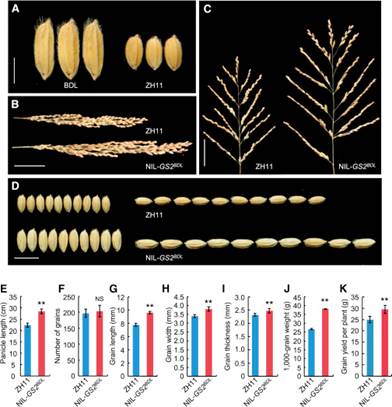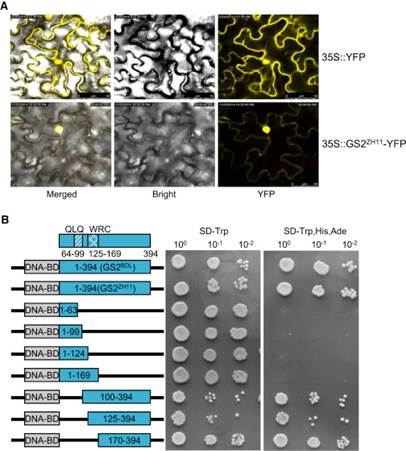


据中国水稻研究所最新消息,该所超级稻种质创新团队与中科院遗传与发育生物研究所等合作,从浙江地方大粒品种“宝大粒”中成功分离并克隆了一个能够显著提高超级稻产量的重要基因GS2。相关研究成果在线发表于最新一期国际知名的《分子植物》杂志。
水稻产量主要由有效穗数、每穗粒数和谷粒重三要素决定,其中谷粒重一般由千粒重表示,是粒长、粒宽和粒厚的综合体现。目前通过增加千粒重来提高水稻产量已经是育种家普遍使用的有效手段。
研究团队在上世纪90年代从国家水稻种质资源中期库获取了一份千粒重在48克以上的“宝大粒”。通过QTL(数量性状基因座,是指控制数量性状的基因在基因组中的位置)分析和高世代回交群体,在第2染色体上获得了一个主效粒型QTL基因GS2。该基因编码了一个水稻生长调控因子OsGRF4。研究人员发现,来自“宝大粒”的GS2等位基因在miR396c靶点发生了一个稀有显性突变,造成该基因表达显著上升,从而促进细胞的分裂和生长,并最终特异增加了穗长和籽粒大小。
田间试验发现,该GS2显性等位基因可显著提高水稻产量。两优培九为我国第一个两系杂交稻的超级稻品种,推广种植面积累计已超亿亩。该GS2显性等位基因可使两优培九亲本9311增加40%以上的千粒重和14%以上的小区产量;而将其与培矮64S品种配成杂交稻后,可比超级稻两优培九品种进一步增产9.5%。此外,研究人员还发现该GS2显性基因在杂合状态下更符合生产需求。(来源:科技日报)
A Rare Allele of GS2 Enhances Grain Size and Grain Yield in Rice
Abstract Grain size determines grain weight and affects grain quality. Several major quantitative trait loci (QTLs) regulating grain size have been cloned; however, our understanding of the underlying mechanism that regulates the size of rice grains remains fragmentary. Here, we report the cloning and characterization of a dominant QTL, GRAIN SIZE ON CHROMOSOME 2 (GS2), which encodes Growth-Regulating Factor 4 (OsGRF4), a transcriptional regulator. GS2 localizes to the nucleus and may act as a transcription activator. A rare mutation of GS2 affecting the binding site of a microRNA, OsmiR396c, causes elevated expression of GS2/OsGRF4. The increase in GS2 expression leads to larger cells and increased numbers of cells, which thus enhances grain weight and yield. The introduction of this rare allele of GS2/OsGRF4 into rice cultivars could significantly enhance grain weight and increase grain yield, with possible applications in breeding high-yield rice varieties.
原文链接:http://ac.els-cdn.com/S1674205215002968/1-s2.0-S1674205215002968-main.pdf?_tid=7c2d9466-55c4-11e5-b2ec-00000aab0f27&acdnat=1441673989_6d2bad99481dd0b91a4439fc1347f72a



